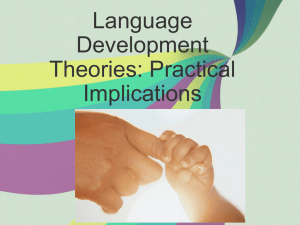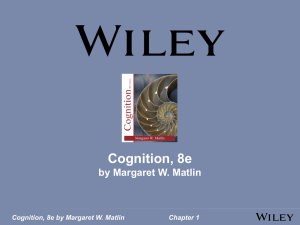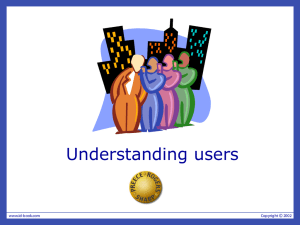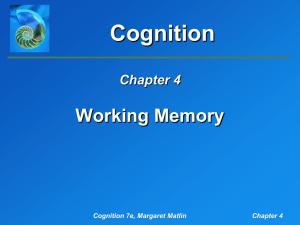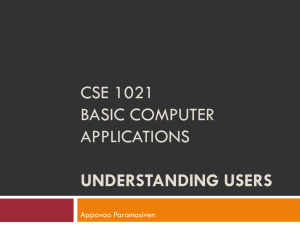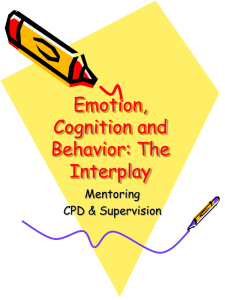Matlin, Cognition, 7e, Chapter 7: Mental Imagery and Cognitive Maps
advertisement
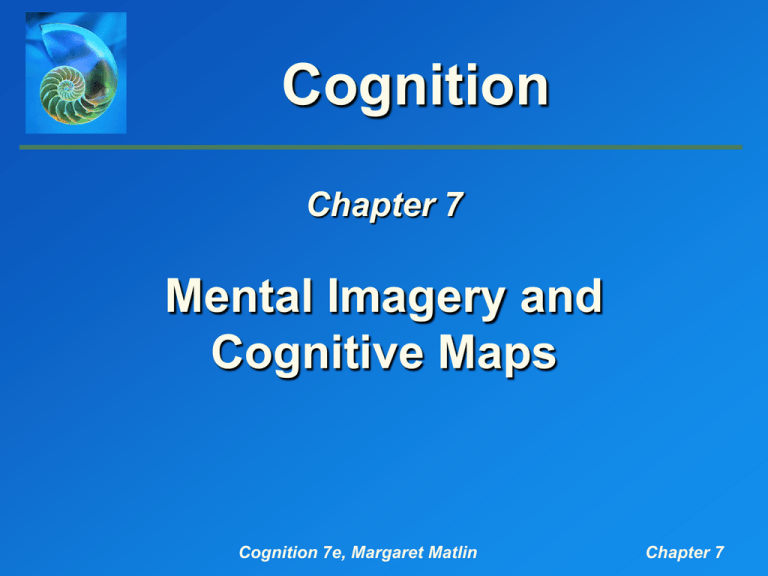
Cognition Chapter 7 Mental Imagery and Cognitive Maps Cognition 7e, Margaret Matlin Chapter 7 Introduction imagery mental maps top-down processing relevance to cognitive psychology professions visual imagery vs. auditory, olfactory, touch, and taste imagery Wundt vs. behaviorists vs. modern cognitive psychology Cognition 7e, Margaret Matlin Chapter 7 The Characteristics of Mental Images not directly observable fade quickly Imagery debate perception vs. language analog code (depictive representation/pictorial representation) vs. propositional code (descriptive representation) Cognition 7e, Margaret Matlin Chapter 7 The Characteristics of Mental Images studying mental imagery—if a mental image resembles a physical object, then people must make judgments about a mental image in the same way that they make judgments about the corresponding physical object Cognition 7e, Margaret Matlin Chapter 7 The Characteristics of Mental Images Imagery and Rotation Shepard and Metzler's Research same/different task using pairs of line drawings images two- vs. three-dimensions reaction time to decide same/different Cognition 7e, Margaret Matlin Chapter 7 The Characteristics of Mental Images Imagery and Rotation decision time influenced by the amount of rotation required to match the figures Cognition 7e, Margaret Matlin Chapter 7 The Characteristics of Mental Images Imagery and Rotation decision time influenced by the amount of rotation required to match the figures Cognition 7e, Margaret Matlin Chapter 7 Mental Rotation Cognition 7e, Margaret Matlin Chapter 7 The Characteristics of Mental Images Imagery and Rotation Recent Research on Mental Rotation other stimuli age practice ASL support for the analog coding approach Cognition 7e, Margaret Matlin Chapter 7 The Characteristics of Mental Images Imagery and Distance Stephen Kosslyn time to scan the distance between two points in a mental image experimenter expectancy distance in auditory images Cognition 7e, Margaret Matlin Chapter 7 Imagery and Distance • • • • • KMCC Mall Bowling Center Commissary Enlisted Club Post Office/North • South Fitness Center Cognition 7e, Margaret Matlin Chapter 7 The Characteristics of Mental Images Imagery and Shape Paivio (1978) hands on imaginary clock high-imagery vs. low-imagery participants Shepard and Chipman (1970) more complex shapes U.S. states Cognition 7e, Margaret Matlin Chapter 7 The Characteristics of Mental Images Conclusions About The Characteristics of Mental Images (so far) 1. When people rotate a mental image, a large rotation takes them longer, just as they take longer when making a large rotation with a physical stimulus. 2. People make distance judgments in a similar fashion for mental images and physical stimuli; this conclusion holds true for both visual and auditory images. Cognition 7e, Margaret Matlin Chapter 7 The Characteristics of Mental Images Conclusions About The Characteristics of Mental Images (so far) 3. People make decisions about shape in a similar fashion for mental images and physical stimuli; this conclusion holds true for both simple shapes (angles formed by hands on a clock) and complex shapes (geographic regions, like Colorado or West Virginia). Cognition 7e, Margaret Matlin Chapter 7 The Characteristics of Mental Images Imagery and Interference Visual and Auditory Imagery visual imagery can interfere with visual perception auditory imagery can interfere with auditory perception Segal and Fusella (1970) create visual or auditory image detect physical stimulus people had more problems detecting the physical stimulus when the image and the signal were in the same sensory mode Cognition 7e, Margaret Matlin Chapter 7 The Characteristics of Mental Images Imagery and Interference Visual and Auditory Imagery Mast and colleagues (1999) imagined lines and real lines produced similar distortions in participants' judgments about the orientation of the line segment Cognition 7e, Margaret Matlin Chapter 7 The Characteristics of Mental Images Imagery and Interference Motor Imagery Wexler and colleagues (1998) joy-stick task involving rotation clockwise or counterclockwise view geometric figure and imagine rotating it clockwise or counterclockwise judge second figure as same or different judgments slower when the motor movement was opposite to the mental image Cognition 7e, Margaret Matlin Chapter 7 Motor Imagery Figure 7.3 Reaction Time, as a Function of the Amount of Mental Rotation and Whether the Mental Rotation Was in the Same Direction as the Hand Movement or in the Opposite Direction Cognition 7e, Margaret Matlin Chapter 7 The Characteristics of Mental Images Imagery and Interference Motor Imagery Wohlschläger (2001) simply planning a motor movement can interfere with trying to rotate a mental image Cognition 7e, Margaret Matlin Chapter 7 The Characteristics of Mental Images Imagery and Ambiguous Figures people sometimes use analog codes and sometimes use propositional codes, when they create a mental image of an ambiguous figure Reed (1974) decide whether a pattern is a portion of a design seen earlier chance performance indicated that people could not have stored mental pictures people must store these pictures as descriptions, in propositional codes Cognition 7e, Margaret Matlin Chapter 7 Imagery and Ambiguous Figures Cognition 7e, Margaret Matlin Chapter 7 The Characteristics of Mental Images Imagery and Ambiguous Figures Chambers and Reisberg (1985) form mental image of ambiguous figure ask participants to provide reinterpretation of ambiguous figure draw figure from memory try to reinterpret physical stimulus Cognition 7e, Margaret Matlin Chapter 7 The Characteristics of Mental Images Imagery and Ambiguous Figures Chambers and Reisberg (1985) (continued) strong verbal propositional code can dominate over an analog code it's easy to reverse an image while you are looking at an ambiguous physical picture, but reversing a mental image is difficult Cognition 7e, Margaret Matlin Chapter 7 The Characteristics of Mental Images Imagery and Ambiguous Figures Analog vs. Propositional codes simple vs. complex figures Finke and colleagues (1989) combine mental images identify new interpretations locate similar, unanticipated shapes in mental images People create mental images using both propositional and analog codes Cognition 7e, Margaret Matlin Chapter 7 The Characteristics of Mental Images Imagery and Other Vision-Like Processes demand characteristics Ishai and Sagi (1995)—masking effect acuity illusory conjunctions Cognition 7e, Margaret Matlin Chapter 7 The Characteristics of Mental Images Revisiting the Imagery Controversy The Analog Viewpoint • create a mental image of an object that closely resembles the actual, physical object • responses to mental images are frequently similar to our responses to physical objects • majority of research supports this position • Kosslyn and coauthors model including subsystems like shifting attention Cognition 7e, Margaret Matlin Chapter 7 The Characteristics of Mental Images Revisiting the Imagery Controversy The Propositional Viewpoint • mental images stored in an abstract, language-like form that does not physically resemble the original stimulus • Pylyshyn mental images not a necessary component of imagery differences between perceptual experiences and mental images Cognition 7e, Margaret Matlin Chapter 7 The Characteristics of Mental Images Revisiting the Imagery Controversy • • • • May not be able to resolve controversy Most researchers favor an analog code For some stimuli and several specific tasks, people may use a propositional code Mental images and perceptual experiences use many of the same brain structures Cognition 7e, Margaret Matlin Chapter 7 The Characteristics of Mental Images Individual Differences: Gender Comparisons in Spatial Ability Most gender differences in cognitive abilities are small Cognition 7e, Margaret Matlin Chapter 7 The Characteristics of Mental Images Individual Differences: Gender Comparisons in Spatial Ability meta-analysis—a statistical method for combining numerous studies on a single topic effect size (d) meta-analyses of gender differences in verbal ability find effect sizes "close to zero" or "small" meta-analyses of gender differences in mathematical ability find effect sizes "close to zero" meta-analyses of gender differences in spatial ability find effect sizes ranging from "small" to "large" Cognition 7e, Margaret Matlin Chapter 7 Meta-Analyses of Cognitive Skills Cognition 7e, Margaret Matlin Chapter 7 The Characteristics of Mental Images Individual Differences: Gender Comparisons in Spatial Ability Spatial ability represents several different skills spatial visualization ("small" gender differences) spatial perception ("moderate" gender differences) mental rotation ("moderate" to "large" gender differences) Cognition 7e, Margaret Matlin Chapter 7 The Characteristics of Mental Images Individual Differences: Gender Comparisons in Spatial Ability Spatial ability represents several different skills mental rotation ("moderate" to "large" gender differences) (continued) possible biological factors but some studies report no gender differences effects of task instructions effects of training experiences with toys and sports that emphasize spatial skills Cognition 7e, Margaret Matlin Chapter 7 Cognitive Neuroscience Research on Mental Imagery Neuroscience Research Comparing Visual Imagery and Visual Perception Kosslyn (2004)—a survey of the research finds that visual imagery activates about two-thirds of the same brain regions that are activated during visual perception Lesions in the visual cortex—mental-imagery impairments resemble perceptual impairments Brain-imaging and the primary visual cortex Cognition 7e, Margaret Matlin Chapter 7 Cognitive Neuroscience Research on Mental Imagery Neuroscience Research Comparing Visual Imagery and Visual Perception Similar patterns of stimulation for visual perception and visual imagery Different tasks activate different areas of the brain Primary visual cortex—inspect a mental image of a visual image Parietal lobe—make changes in the structure of their visual images Cognition 7e, Margaret Matlin Chapter 7 Cognitive Neuroscience Research on Mental Imagery Neuroscience Research on Mental Rotation Tasks Kosslyn, Thompson and coauthors (2001) rotate geometric figures with hands vs. watch an electric motor rotate the figures perform Shepard and Metzler same/different task rotating the figures mentally PET scan—participants who had rotated the original geometric figure with their hands, now showed activity in the primary motor cortex; participants who only watched did not Cognition 7e, Margaret Matlin Chapter 7 Cognitive Neuroscience Research on Mental Imagery Neuroscience Research on Mental Rotation Tasks instructions to "rotate this figure" activate the primary motor cortex and the right parietal cortex "rotate self" activates the left temporal lobe and a different part of the motor cortex Cognition 7e, Margaret Matlin Chapter 7 Cognitive Maps Background Information About Cognitive Maps cognitive map—mental representation of the environment that surrounds us neighborhoods, cities, countries real-world settings ecological validity Cognition 7e, Margaret Matlin Chapter 7 Cognitive Maps Background Information About Cognitive Maps spatial cognition—our thoughts about spatial issues; cognitive maps, remembering the world we navigate, keeping track of objects in a spatial array • • environmental psychology, computer science, linguistics, anthropology, geography, architecture, urban planning our knowledge of spatial cognition includes an enormous amount of commonsense information Cognition 7e, Margaret Matlin Chapter 7 Cognitive Maps Background Information About Cognitive Maps individual differences quite large cognitive maps both analog and propositional Cognition 7e, Margaret Matlin Chapter 7 Cognitive Maps Background Information About Cognitive Maps Roskos-Ewaldsen and colleagues (1998) survey knowledge—the relationship among locations that you directly acquire by learning a map or by repeatedly exploring an environment orientation of map judgments are easier when your mental map and the physical map have matching orientations Cognition 7e, Margaret Matlin Chapter 7 Cognitive Maps Cognition 7e, Margaret Matlin Chapter 7 Cognitive Maps Background Information About Cognitive Maps Cognitive maps are generally accurate Errors can be traced to rational strategies; systematic distortions of reality Cognition 7e, Margaret Matlin Chapter 7 Cognitive Maps Cognitive Maps and Distance estimating the distance between two known points MacDonalds in Landstuhl near A6 to Globus Use A6 _____ km Use Kaiserstrasse through Kindsbach _____ km Cognition 7e, Margaret Matlin Chapter 7 Cognitive Maps Cognitive Maps and Distance Number of Intervening Cities Thorndyke (1981) study map of hypothetical region until you can reproduce it 0, 1, 2, or 3 other cities along the route between two cities estimate the distance between specified pairs of cities the number of intervening cities had a clear-cut influence on estimates "cluttered" routes seem longer roads with complex turns seem longer than straight roads Cognition 7e, Margaret Matlin Chapter 7 Cognitive Maps Cognitive Maps and Distance Semantic Categories semantic factors influence distance estimates for specific locations Hirtle and Mascolo (1986) learn hypothetical map of a town estimate distance between pairs of locations people tended to shift each location closer to other sites that belonged to the same semantic cluster campus and off-campus buildings North American cities Cognition 7e, Margaret Matlin Chapter 7 Cognitive Maps Cognitive Maps and Distance Landmarks Versus Nonlandmarks as Destinations landmark effect—general tendency to provide shorter estimates when traveling to a landmark, rather than a nonlandmark Cognition 7e, Margaret Matlin Chapter 7 Cognitive Maps Cognitive Maps and Distance Landmarks Versus Nonlandmarks as Destinations McNamara and Diwadker (1997) memorize map containing pictures of objects some objects described as landmarks, others not estimate distance between various pairs of objects asymmetry in distance estimates consistent with the landmark effect prominent destinations seem closer than less important destinations Cognition 7e, Margaret Matlin Chapter 7 Cognitive Maps Cognitive Maps and Shape We tend to construct cognitive maps in which the shapes are more regular than they are in reality. Cognition 7e, Margaret Matlin Chapter 7 Cognitive Maps Cognitive Maps and Shape Angles Moar and Bower (1983) cognitive maps of Cambridge, England estimates for the angles formed by the intersection of two streets tendency to "regularize" the angles so that they were more like 90 degree angles heuristic—general problem-solving strategy degree-angle heuristic—represent angles on a map as being closer to 90 degrees than they really are Cognition 7e, Margaret Matlin Chapter 7 Cognitive Maps Cognitive Maps and Shape Curves symmetry heuristic—we remember figures as being more symmetrical and regular than they truly are Cognition 7e, Margaret Matlin Chapter 7 Cognitive Maps Cognitive Maps and Relative Position Stevens and Coupe (1978)—east/west and north/south judgments of cities Tversky—we use heuristics when we represent relative positions in our mental maps The Rotation Heuristic & The Alignment Heuristic Cognition 7e, Margaret Matlin Chapter 7 Cognitive Maps Cognitive Maps and Relative Position The Rotation Heuristic rotation heuristic—we remember a tilted geographic structure as being either more vertical or more horizontal than it really is California; U.S./Canada border Tversky (1981) mental maps for San Francisco Bay area 69% of students showed evidence of the rotation heuristic cross-cultural evidence Cognition 7e, Margaret Matlin Chapter 7 Rotation Heuristic Cognition 7e, Margaret Matlin Chapter 7 Cognitive Maps Cognitive Maps and Relative Position The Alignment Heuristic alignment heuristic—we remember geographic structures as being arranged in a straighter line than they really are Tversky (1981) pairs of cities which city is north (or east) of the other? many students showed a consistent tendency to use the alignment heuristic especially for northern cities in North America compared to southern cities in Europe Cognition 7e, Margaret Matlin Chapter 7 Alignment Heuristic Cognition 7e, Margaret Matlin Chapter 7 Cognitive Maps Cognitive Maps and Relative Position Heuristics make sense, but can cause us to miss important details and fail to pay attention to bottom-up information. Cognition 7e, Margaret Matlin Chapter 7 Cognitive Maps In Depth: Creating Cognitive Maps creating a cognitive map from descriptions or directions similar to maps created from looking at a scene integrate information from separate statements Cognition 7e, Margaret Matlin Chapter 7 Cognitive Maps In Depth: Creating Cognitive Maps Franklin and Tversky's Research verbal descriptions of ten different scenes five objects imagine facing one of the objects; specify which object located in each of several directions Cognition 7e, Margaret Matlin Chapter 7 Cognitive Maps In Depth: Creating Cognitive Maps Franklin and Tversky's Research (continued) • • • response times to answer which objects were above and below were short people required longer to decide which objects were ahead or behind even longer to decide which objects were to the right or to the left Cognition 7e, Margaret Matlin Chapter 7 Cognitive Maps In Depth: Creating Cognitive Maps The Spatial Framework Model spatial framework model—emphasizes that the above-below spatial dimension is especially important in our thinking, the front-back dimension is moderately important, and the right-left dimension is least important 1. The vertical dimension is correlated with gravity 2. The vertical dimension on an upright human’s body is physically asymmetric. Cognition 7e, Margaret Matlin Chapter 7 Cognitive Maps In Depth: Creating Cognitive Maps The Spatial Framework Model (continued) Our cognitive maps reveal certain biases based on our long-term interactions with our bodies and with the physical properties of the external world. Cognition 7e, Margaret Matlin Chapter 7 Cognitive Maps In Depth: Creating Cognitive Maps Further Research on Creating Cognitive Maps second person vs. third person descriptions Bryant, Tversky and Franklin (1992)—readers typically prefer to adopt the perspective of the observer rather than remaining outside the scene cognitive maps derived from descriptions represent: orientation, point of view, landmarks, and distance Cognition 7e, Margaret Matlin Chapter 7

